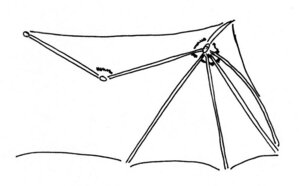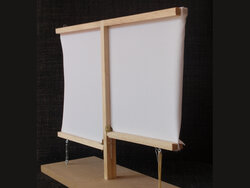A flexible banner inspired by compliance in nature
The common buildings and building techniques result in very stiff structures even when stiffness isn’t necessary. These structures contain a lot of material to reach this stiffness. In this project we investigate flexibility and flexible structures. With the gained knowledge we try to develop a banner which uses flexibility to reduce the forces on the structure and so reduce the amount of material.
In the first part of the project a literature study is done about flexibility and compliance in nature. At first flexibility is defined and divided in different phenomena. Here one can think about a more aerodynamic structure or reducing the loaded surface when the loads increase. After that, organisms in nature are analyzed because nature developed over billions of years and, by the theory of Darwin, only the fittest organisms survived. The flexibility here is often amazing even as the efficient use of material. The different organisms are analyzed and general principles are derived. With these principles and by abstracting the structural design of organisms a concept for a flexible banner is created.
The concept of the flexible banner is mainly based on the bat-wing. The banner exists of stiff members with in between a flexible membrane. The members are interconnected by springs and can rotate regarding each other. Due to this rotation the membrane deforms which leads to a different geometry. By using this deformation in a right way it should lead to a reduction of forces on the structure.
In this project we investigate the different variables of the banner and determine the influence of these variables on the geometry and the forces on and in the structure.
The different variables are investigated by using different finite element programs. At first we use GSA to make non-linear calculations and finding the geometry in the deformed state when the structure is loaded.
We create in Ansys Fluent a virtual wind tunnel were we put in the different models. The different pressure coefficients are derived and by analyzing the output we can determine the influence of the different variables on the forces on the geometry and the flows in the structures.
Due to the large deformations pressure coefficients and loaded surfaces vary largely. By an iterative process the final geometry can be found. This makes the problem complex because the forces on the structure influence the geometry of the structure and this deformed geometry influences the forces on the structure.
At the end a banner should be designed which uses flexibility to reduce the forces on the structure. We should have insight in the influence of the different variables. By using these different variables in a more or less optimized way we should be able to create a structure with less material compared with a stiff structure of the same size. By this flexible banner I try to show the usefulness of flexibility in structural design. In many places we use stiff and heavy structures where there is no need for, like for instance sound barriers or façade structures. By investigating flexibility we could find out where and how we could use flexibility in structural design and nature could be used as a source of inspiration by developing these flexible structures.
Student: Sake Bosma
Commission: A.P.H.W. Habraken / P.M. Teuffel / R.M. Ferraro


